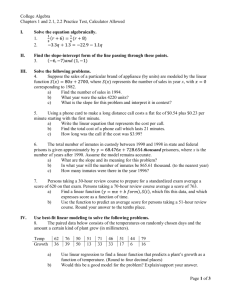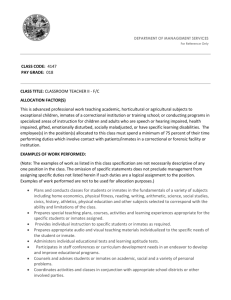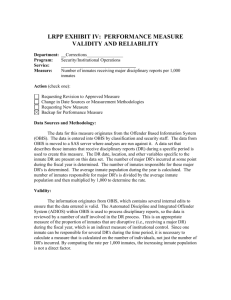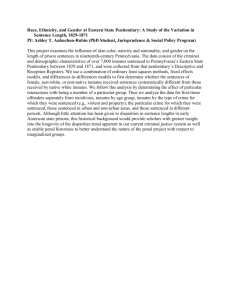CHAPTER 12 Corrections Law and Inmate Litigation TEST BANK
advertisement
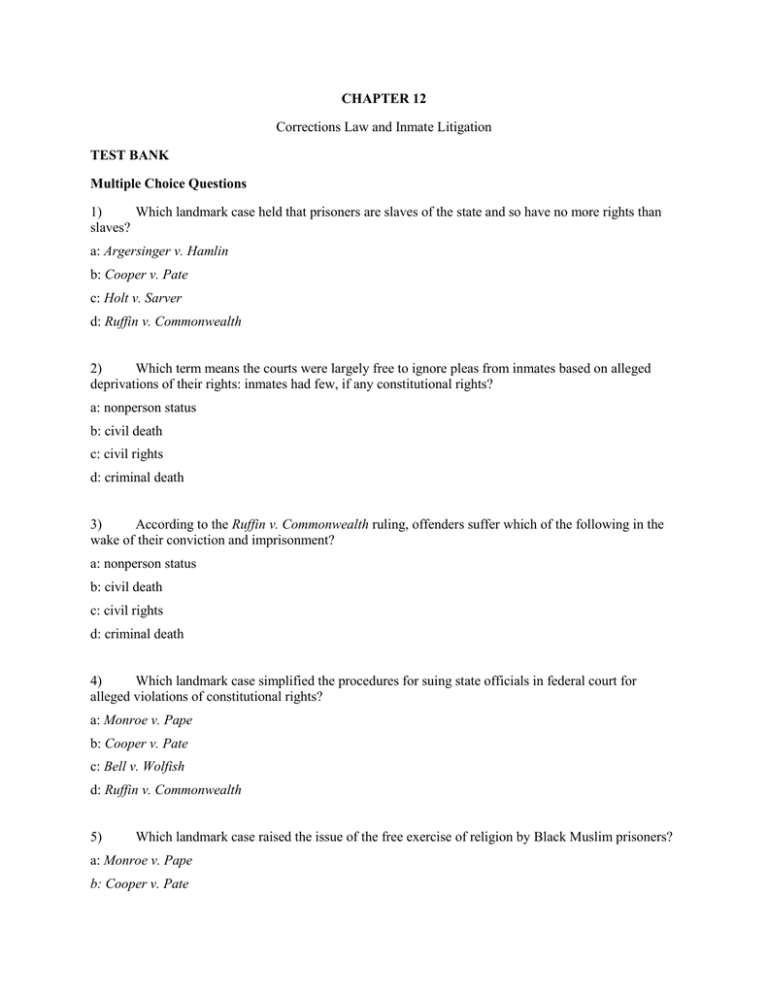
CHAPTER 12 Corrections Law and Inmate Litigation TEST BANK Multiple Choice Questions 1) Which landmark case held that prisoners are slaves of the state and so have no more rights than slaves? a: Argersinger v. Hamlin b: Cooper v. Pate c: Holt v. Sarver d: Ruffin v. Commonwealth 2) Which term means the courts were largely free to ignore pleas from inmates based on alleged deprivations of their rights: inmates had few, if any constitutional rights? a: nonperson status b: civil death c: civil rights d: criminal death 3) According to the Ruffin v. Commonwealth ruling, offenders suffer which of the following in the wake of their conviction and imprisonment? a: nonperson status b: civil death c: civil rights d: criminal death 4) Which landmark case simplified the procedures for suing state officials in federal court for alleged violations of constitutional rights? a: Monroe v. Pape b: Cooper v. Pate c: Bell v. Wolfish d: Ruffin v. Commonwealth 5) Which landmark case raised the issue of the free exercise of religion by Black Muslim prisoners? a: Monroe v. Pape b: Cooper v. Pate c: Bell v. Wolfish d: Ruffin v. Commonwealth 6) Which landmark case decided the cell size in favor of the inmates? a: Monroe v. Pape b: Cooper v. Pate c: Bell v. Wolfish d: Ruffin v. Commonwealth 7) A Section 1983 action must satisfy which of the following requirements? a: the defendant must be a person b: the defendant must be acting under color of state law c: the injury to the inmate-plaintiff must involve a violation of a protected right d: all of the above 8) Jailhouse lawyers are also referred to as: a: ambulance chasers b: writ writers c: technical writers d: licensed attorneys 9) Which landmark case extended the state’s responsibility to provide legal aid to inmates? a: Johnson v. Avery b: Johnson v. Smith c: Avery v. Smith d: Bounds v. Smith 10) Which term describes law suits in which inmates represent themselves? a: class action lawsuit b: writ of habeas corpus c: pro se action d: due process 11) Which type of law suit is brought on behalf of prisoners as a group? a: class action lawsuit b: writ of habeas corpus c: pro se action d: due process 12) Which landmark court decision expanded legal protections to parolees? a: Monroe v. Pape b: Cooper v. Pate c: Bell v. Wolfish d: Morrissey v. Brewer 13) Which landmark court decision formally defined the due process rights of probationers? a: Monroe v. Pape b: Cooper v. Pate c: Gagnon v. Scarpelli d: Morrissey v. Brewer 14) Which landmark court decision ruled definitively that double-bunking does not necessarily constitute cruel and unusual punishment? a: Monroe v. Pape b: Cooper v. Pate c: Bell v. Wolfish d: Morrissey v. Brewer 15) Which of the following describes when corrections officials knew about but did nothing about an inmate’s physical or medical condition? a: in deliberate indifference b: deliberate difference c: in deliberate difference d: deliberate indifference 16) Which landmark court decision ruled that potential harm might result from exposure to environmental tobacco smoke and noted that actions should be taken to reduce or eliminate that harm? a: Helling v. McKinney b: Monroe v. Pape c: Bell v. Wolfish d: Morrissey v. Brewer 17) Which landmark court decision articulated a test for all excessive use of force cases in a prison setting? a: Helling v. McKinney b: Monroe v. Pape c: Hudson v. McMillian d: Morrissey v. Brewer 18) Which landmark court decision held that the death penalty was unconstitutional because of overly broad jury discretion? a: Monroe v. Pape b: Hudson v. McMillian c: Morrissey v. Brewer d: Furman v. Georgia 19) How many prisoners were on death row at the end of 2010? a: 2,100 b: 3,100 c: 31,000 d: 21,000 20) Factors that diminish the seriousness of the crime are known as: a: aggravating circumstances b: determining factors c: mitigating circumstances d: indeterminate factors 21) Factors that enhance the seriousness of the crime are known as: a: aggravating circumstances b: determining factors c: mitigating circumstances d: indeterminate factors 22) Which landmark court decision held that the death penalty no longer should be imposed on persons under 18? a: Atkins v. Virginia b: Penry v. Johnson c: Roper v. Simmons d: Gregg v. Georgia 23) To determine the constitutionality of prison official’s actions, the Supreme Court established a measure of inmates’ rights against the prison’s need for security known as: a: unreasonable test b: reasonableness test c: assessment d: action statement 24) Correctional law went through a hands-off period of development during which time period? a: 1871–1963 b: 1964–1978 c: 1979–present d: Prior to 1871 25) Correctional law evolved during the rights period during which time frame? a: 1871–1963 b: 1964–1978 c: 1979–present d: Prior to 1871 26) Litigation used to change social conditions is known as: a: private matter law b: private party law c: public interest law d: public matter law 27) Correctional law has been evolving since 1979 in the era termed as: a: the rights period b: the hands-off period c: the hands-on period d: the deference period 28) A civil rights claim is also known as: a: class action lawsuit b: Section 1983 suit c: liability d: mitigating circumstance 29) Which landmark case ruled that the right of an accused to be represented by an attorney is not confined to trials alone, that counsel is required at every stage where substantial rights of the accused may be affected? a: Mempa v. Rhay b: Morrissey v. Brewer c: Gagnon v. Scarpelli d: Bell v. Wolfish 30) What area of prison concern encompasses visitation and correspondence policies, administrative segregation, classification policies, and disciplinary and grievance procedures? a: staffing b: institutional governance c: deliberate indifference d: health and safety issues True/False Statements Decide whether each of these statements is true or false 1) When rioting broke out at the Penitentiary of New Mexico in 1980 many policy makers and private citizens understood that something was very wrong in the nation’s prisons. 2) A Section 1983 action must satisfy several requirements including; the injury to the inmate-plaintiff must involve a violation of a protected right. 3) Jim Thomas says that the growth of civil rights petitions versus writs of habeas corpus came about because state inmates were not interested in using the state courts to secure their release. 4) In Bell v. Wolfish the court decided just one issue—lunch requirements—in favor of the inmates. 5) In the 1970s, one reason for the increase in prisoners’ lawsuits, was simply an increased number of prisoners. 6) In the Supreme Court ruling Johnson v. Avery (1969) centered on a prison regulation that prohibited inmates from giving one another legal help. 7) Inmates have often had the economic resources to undertake a wide-ranging and protracted class action lawsuit—a suit brought on behalf of prisoners as a group. 8) In Morrissey v. Brewer (1972) the court addressed the nature of due process for parolees. 9) The Supreme Court ruled that county commissioners and a sheriff can be held personally liable for refusing to provide treatment to a jail inmate who is suffering from cancer. 10) In Gagnon v. Scarpelli (1973) the Supreme Court formally defined the due process rights of probationers including a preliminary hearing to decide if probable cause exists. 11) Litigation has been one of the major influences in changing correctional practices since 1970. 12) Many of the corrections lawsuits brought in the 1960s and 1970s dealt with sentencing. 13) In Furman v. Georgia (1972) the examination of litigation and the death penalty began. 14) In 37 of the 38 states that allow capital punishment death sentences are not reviewed. 15) In Atkins v. Virginia (2002) the Supreme Court’s majority opinion (by a six to three vote) noted that a number of states now allow the execution of mentally retarded persons. 16) In Georgia, in death penalty cases the first phase is where the jury decides the question of guilt. 17) Each year roughly the same number of people sentenced to death leave death row. 18) The public opinion polls show strong and continuing support for the death penalty. 19) Prisoner rights are dealt with consistently from country to country. 20) With regard to inmate lawsuits the hands-off period lasted from 1871 through 1963. Fill in the Blanks 1) The ______________ _____________ of 1976 guarantees inmates access to courts for any violations of their rights. 2) To determine the constitutionality of prison officials’ actions, the Supreme Court established the _________________ ____________ a measure of inmates’ rights against the prison’s need for security. 3) The ________________ courts were very much hands-on during the rights period from 1964 to 1978. 4) Legislation, particularly at the _______________ level, has been an important instrument of social change for women and minority groups in the United States. 5) Corrections law has gone through three distinct periods of development with the last one titled the _______________ ______________: from 1979 to the present. 6) A __________________ ______________ is the term given for prisoners who are slaves of the state and have no more rights than slaves. 7) By the 1960s, the effectiveness of ___________ ______________ law was clear, as a number of landmark cases used litigation to change social conditions. 8) The case _____________ v. __________ (1964) raised the issue of the free exercise of religion by Black Muslim prisoners. 9) The traditional path for state prisoners to file federal lawsuits was to petition for a ____________ of _______________ _______________. 10) A Section 1983 action requirement is that a ________________ must be a real person. 11) From 1980 to 2000 prisoner litigation increased dramatically because there was an increase inmate _________________. 12) The intent of the ___________ __________ of _____________ __________ _____ was to reduce the number of Section 1983 claims filed by state inmates by requiring prisoners to exhaust all state administrative remedies before filing a federal suit. 13) _____________ v. ____________(1969) centered on a prison regulation that prohibited inmates from giving one another legal help. 14) The court’s ruling in ______________ v. ______________ (1972) expanded legal protections to parolees. 15) In ____________ v. _______________ (1973) the Supreme Court formally defined the due process rights of probationers. 16) Crowding is certainly a factor in facilities relying on ____________-_____________ when two inmates are housed in a cell that was designed to house one. 17) __________________ ________________ encompasses visitation and correspondence policies, administrative segregation, classification policies, and disciplinary and grievance procedures. 18) One of the earliest cases addressing the issue of opposite-gender staff guarding inmates was ___________ v. _____________ (1981). 19) The most unusual legal challenge involving the internet, Maricopa County, Arizona, Sheriff ___________ ______________ has been sued over his practice of installing webcams throughout his jail showing the inmates and their daily routines. 20) In the sentencing hearing juries now must consider ______________ and ____________ _________________ , which are factors that diminish or enhance the seriousness of the crime. Matching Match the words in the list to the following statements: A) class action lawsuit; B) Furman v. Georgia; C) civil rights claim; D) pro se actions; E) rights period; F) Atkins v. Virginia; G) deliberate indifference; H) Civil Rights of Institutionalized Persons Act ; I) Prison Reform Litigation Act; J) nonperson status ________1) Suits in which inmates represent themselves. ________2) This case resolved whether it is constitutional to execute a person who is mentally retarded. ________3) Corrections law period of development from 1964 to 1978. ________4) Courts were largely free to ignore pleas based on alleged deprivations of their rights, inmates had few, if any, constitutional rights. ________5) A Section 1983 suit. ________6) This affirmed that state inmates must exhaust all of their state administrative remedies before filing a claim in a federal court; it also required inmates to pay appropriate appellate fees. ________7) A suit brought on behalf of prisoners as a group. ________8) Corrections officials knew about but did nothing about the inmate’s physical or medical condition, and that the failure to act had long-term effects on the inmate’s condition. ________9) A divided Supreme Court struck down as unconstitutional the death penalties of Georgia and most other states in this case. ________10) Intent of this law was to reduce the number of Section 1983 claims filed by state inmates by requiring prisoners to exhaust all state administrative remedies before filing a federal suit.

